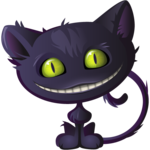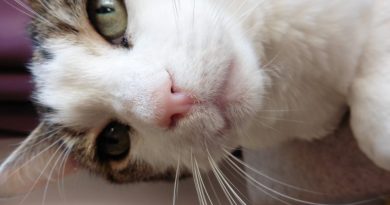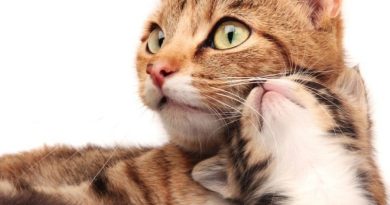Do cats dream?
Do Cats Dream?
Cats can spend up to 23 hours a day snoozing, catnapping, catching forty winks or otherwise dead to the world. They have 2 main mottos – “If in doubt, wash” and “If bored, sleep”. They are masters of the art of sleeping draped over branches or chairbacks, curled into impossibly tight balls or sprawled out, snoring, on freshly fluffed duvets. As they slumber, paws flex and relax, claws extend and retract, legs and whiskers twitch and mouths make quiet chattering or mumbling noises. Do our purry furry friends dream and, if so, of what?
Human dreams are based on things we’ve experienced, seen or read, sprinkled with a liberal dose of imagination. Cats also recall previous experiences; vanishing when the flea-spray appears. They also remember things they’ve seen – like how to open catflaps after watching other cats doing it. Scenes from wildlife programmes or ‘video catnip’ tapes, where the prey is tantalisingly out of reach, may well feature in feline dreams.
Though it may seem odd to credit cats with powers of imagination, they sometimes think problems through rather than solving them by trial and error. One pair of imaginative felines quickly worked out how to reach doorhandles by standing one on the other’s back rather than just jumping up at the handle. Others seem adept at unbolting catflaps.
What do all those fast-asleep paw movements and chattering noises mean during RPM (Rapid Paw Movement) sleep? Maybe the slumberer is remembering a hunting trip. Though not all cats have hunted real prey, they have inherited all the right instincts. Many of those fast-asleep paw movements resemble small pouncing or swatting motions. Cats often chatter in frustration when prey eludes them. By the amount of chattering Jack does when asleep, dream hunts, like real life hunts, are often unsuccessful.
If you watch closely, you might be able to work out what scenario is being enacted or re-enacted in your cat’s dream. Those little movements are all clues to what is going on inside that cute furry head. That twitching tail could mean ‘stalking prey’, ‘poised to pounce’ or ‘seen something interesting’. When followed by a paw-twitch, a whisker twitch and a raised lip (maybe even exposing the canine) the dream prey has been dispatched. Sometimes Jack even licks his lips afterwards, other times he seems to be playing with his catch. Teeth chattering and tail lashing probably means the dream prey got away.
Other pleasurable experiences such as dinner-time, kittenhood, being gently groomed, rambling-in-the-garden, rolling belly-up in sunbeams or tormenting the family dog probably feature in feline dreams. How often do you accidentally wake your cat and get rewarded by that expression which says ‘I was having such a lovely dream’? Like people, some cats must dream more vividly or imaginatively than others.
During sleep, our brain releases inhibiting substances to prevent us from acting out our dreams fully, although we may toss, turn and even talk in our sleep. The feline brain works similarly. In laboratory experiments where unfortunate feline subjects have had their brains tampered with so that those substances aren’t released, the cats act out their dreams in full. Even laboratory-bred cats which have never hunted, or even seen prey, have been observed to ‘catch birds’, ‘chase mice’ and ‘bat prey’ in the course of their dreams.
Take a peek at your slumbering cat. Are those paws patting your knitting or pouncing on prey? Is that a murmur of contentment or a curse of frustration? That belly-up, blissful snoring pose – a dream of nursing kittens, of sunbathing or of being lovingly stroked? Next time you find your cat in the land of nod, watch closely and see if you can work out what it is dreaming.
Courtesy of Sarah Hartwell – Animal Behavioural Expert UK



